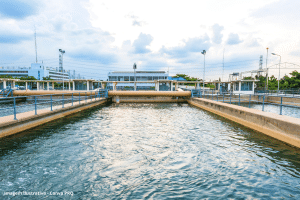Lewabrane® goes Seawater
LANXESS LPT now offers two different kinds of Seawater RO elements to meet the needs in different regions.
Lewabrane HR and HF Seawater elements
Seawater salinity levels vary throughout the world. There are very high salinity regions, like the Arabian Gulf, and low salinity regions, like the Atlantic and Pacific oceans. The SWRO system design and application is different as a result of these differing TDS concentrations, and feed water temperatures.
Lanxess LPT launched our Lewabrane S400 HR in early June at the SIWW conference. This element offers 6500 gpd water productivity and 99.8% salt rejection under standard SWRO test conditions. The S400 HR product is preferred in high salinity applications. This product is also available in a 440 ft2 area, designated S440 HR, and provides 7200 gpd water productivity at standard test conditions.
Lanxess LPT will launch a more permeable, higher water productivity SWRO element shortly. This product, designated S400 HF, will offer 9000 gpd water productivity at 99.8% rejection (under standard test conditions). This product will be useful in regions with lower seawater salinity, and will often be combined with a 2nd pass using high performance BWRO elements. This product type will also be available in a 440 ft2 area version, designated S440 HF.
Please note – although the HR and HF product datasheets will show the same NaCl rejection value of 99.8%, the true rejection of the HR element is higher if one compares the rejection not at the same pressure, but on the same water productivity level. This is the reason the HR elements with a lower water productivity are called high rejection RO elements.
If we think about regions, and differences in seawater salinity, our expectation is that each sales region will orient towards HR and HF type applications according to the rough geography below:
Single pass or double pass systems often depends on the requested Boron level
Although a single pass RO process to desalinate seawater would be the preferred solution, many SWRO plants have an additional desalination step utilizing a second pass to achieve the requested Boron rejection.
Although the WHO recommends a Boron level of 2.4 mg/l in drinking water, which can be achieved by a single pass system, some countries may request a Boron level of The reason is that the wastewater of these countries is used for agriculture, and plants, for example, citrus plants, are sensitive to Boron levels, and require a lower level.
The limitation for boron in drinking and agricultural water application is often very strict (<0.4ppm). This is the reason the Boron rejection is often shown on competitive (and our) SWRO datasheets. Our S400 HR datasheet lists boron rejection of 93,0% under standard conditions with a 5 mg/l B in feed water (S-HF has 92,0 boron rejection under standard conditions).
As you know, Boron rejection is pH dependent, and therefore, the 2nd pass pH may be increased to pH 11 to ensure a high rejection of Boron in the second pass. Of course, this step is expensive, may also lead to scaling in pass 2 (and a neutralization is required afterwards). Our standard BW elements or LE elements can be used for this 2nd pass step
Our Lewabrane RO B440 HR is already successful used in this application in the Seawater desalination plant in Eilat (Israel).
Two Pass – partial and split partial systems
Another consideration in SWRO systems is that the more modern designs can often have partial flow and split partial flow in the 2nd pass. The driver in these design is improved operating efficiency (lower power consumption), and often a 5 -10% reduction in 2nd pass size (lower capital costs). These designs are more popular in large scale SWRO plants where the added complexity and cost, plus the need for highly trained operators is covered by the savings in total water cost. These 2nd pass system configurations are currently supported in LewaPlus.
Hybrid SWRO membrane systems
Another consideration for advanced SWRO design is the application of “hybrid” SWRO design. Usually this means that the SWRO element applied varies either from 1st to 2nd stage in same pass, or different membrane types within the same pressure vessel, independent of pass.
These hybrid designs have become more popular in recent years, especially in large RO systems where small reductions in specific power consumption provide large cost savings.
And, these hybrid designs are also becoming more popular in geographic regions where power costs are relatively high, for example, the Caribbean Islands.
We are aware, for example, of a SWRO system in the Cayman Islands with a hybrid system. In this plant, the SWRO system has a 1st pass which uses an HR membrane type on the feed (or lead) side of the pressure vessels, and an HF type on the back (or tail) side of the pressure vessel. This hybrid sequence operates at lower specific power consumption than a full HR type, lowering operating costs. Please note…, the high rejection types are on the feed side, and designed to have an equal workload with the high flow elements on the back side.
Also note, that in such configurations a second pass is required.
LewaPlus
LewaPlus is supporting already all Lewabrane SW types although the S-HF type shows currently ”not available”. In fact, the current LewaPlus version v1.7, is really powerful. LewaPlus can prepare SWRO designs with consideration of various energy recovery devices (ERDs) like hydraulic turbocharger, and isobaric process. Further, the current LewaPlus can provide advanced RO system configurations like single pass, two pass – full process of permeate, two pass – partial process, and two pass – split partial process. Upgrades to v1.8 will be available by end October. This next version will add hybrid stage and hybrid pressure vessel designs to our portfolio.
Reference SWRO plant using Lewabrane
The first Lewabrane SW reference plant has been operation since April 2014 without any problem. The plant is located in Sharm El Sheik (Egypt) and produces water for the Hilton Hotel. The operating performance details of this plant were presented during the SIWW from the German Seawater organization (DME). This presentation can be found on COM.
Available SW sales tools and documentation
The following documentation is available for Lewabrane SW application
1. Lewabrane SW brochure, available on COM
2. S400 HR, S440 HR and S085 HR data sheets, available on the LPT web site, or thru
LewaPlus product scout
3. SIWW/ DME (Mertes) presentation of S400 HR pilot, available on COM
4. The datasheet of the S-HF types are available on COM
Conclusion
The Lewabrane SWRO products are state-of-the-art RO membrane elements fully competitive with the SWRO products offered by major competitors. Our SW portfolio is still not as full as competition, but where we match up, the Lewabrane SWRO performance for flow and rejection is fully competitive.
Our reference SWRO documentation continues to expand, and our LewaPlus design software offers advanced design capabilities that the other design software cannot match. The October v1.8 LewaPlus release will make us even better. This is a good story for both
our OEMs and distribution partners.





















































